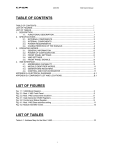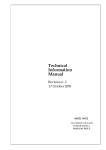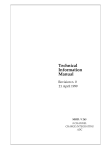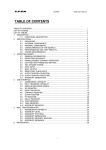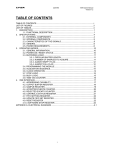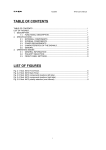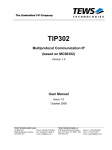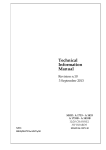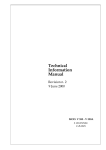Download Technical Information Manual
Transcript
Technical Information Manual Revision n. 0 25 January 2001 MOD. V534 8 CHANNEL FLASH ADC WITH MEMORY CAEN will repair or replace any product within the guarantee period if the Guarantor declares that the product is defective due to workmanship or materials and has not been caused by mishandling, negligence on behalf of the User, accident or any abnormal conditions or operations. CAEN declines all responsibility for damages or injuries caused by an improper use of the Modules due to negligence on behalf of the User. It is strongly recommended to read thoroughly the CAEN User's Manual before any kind of operation. CAEN reserves the right to change partially or entirely the contents of this Manual at any time and without giving any notice. 25/01/96 V534 User's Manual TABLE OF CONTENTS TABLE OF CONTENTS ...................................................................................................... i LIST OF FIGURES............................................................................................................. i LIST OF TABLES ............................................................................................................... ii 1. DESCRIPTION............................................................................................................. 1 1.1. FUNCTIONAL DESCRIPTION ....................................................................... 1 2. SPECIFICATIONS........................................................................................................ 3 2.1. EXTERNAL COMPONENTS .......................................................................... 3 2.2. INTERNAL COMPONENTS ........................................................................... 3 2.3. POWER REQUIREMENTS ............................................................................ 3 2.4. CHARACTERISTICS OF THE SIGNALS ........................................................ 4 2.5. GENERAL .................................................................................................... 4 3. OPERATING MODES................................................................................................... 7 3.1. GENERAL INFORMATION............................................................................ 7 3.2. POWER-ON CONFIGURATION..................................................................... 8 3.3. VME SETTINGS............................................................................................ 8 3.4. FRONT PANEL SIGNALS.............................................................................. 8 3.5. MEMORY BLOCKS READOUT...................................................................... 9 4. VME INTERFACE ........................................................................................................ 10 4.1. ADDRESSING CAPABILITY .......................................................................... 10 4.2. MEMORY BLOCKS CONTENT...................................................................... 13 4.3. SET MODE "REGISTER" REGISTER............................................................. 13 4.4. SET MODE "MEMORY" REGISTER............................................................... 13 4.5. RESET REGISTER ....................................................................................... 14 4.6. STOP REGISTER ......................................................................................... 14 4.7. RELEASE BLOCK A REGISTER.................................................................... 14 4.8. RELEASE BLOCK B REGISTER.................................................................... 14 4.9. LATCH AND STATUS REGISTERS ............................................................... 14 4.10. DAC SET REGISTER.................................................................................... 16 4.11. EVENT COUNTER REGISTER...................................................................... 16 LIST OF FIGURES Fig. 1.1: V534 Block Diagram .............................................................................................. 2 Fig. 2.1: Mod. V534 Front Panel .......................................................................................... 5 Fig. 2.2: Mod. V534 Components Locations ......................................................................... 6 Fig. 3.1: Mod. V534 Digitization Diagram.............................................................................. 7 Fig. 4.1: Mod. V534 Base Address Setting ........................................................................... 12 Fig. 4.2: Memory Blocks Content ......................................................................................... 13 Fig. 4.3: Latch and Status Registers .................................................................................... 15 Fig. 4.4: Complete Address of the Memory Locations ........................................................... 15 Fig. 4.5: DAC Set Register .................................................................................................. 16 Fig. 4.6: Event Counter Register.......................................................................................... 16 i 25/01/96 V534 User's Manual LIST OF TABLES Table 4.1: Address Map for the Mod. V534 in Memory Mode................................................. 10 Table 4.2: Address Map for the Mod. V534 in Register Mode ................................................ 11 ii 25/01/96 V534 User's Manual 1. DESCRIPTION 1.1.FUNCTIONAL DESCRIPTION The CAEN Model V534 is a FLASH ADC WITH MEMORY housed in a 1-unit wide VME module that implements the functions of an 8-channel 8 bit voltage sampling Analog-toDigital Converter (a functional block diagram is shown in Fig. 1.1). The ADC block converts a differential analog voltage that must lie between +1.5 V and +3.3 V. The User can sample an input signal (IN) varying in a 512 mV range with a pedestal value that can be set between 0 V and +2.5 V via an internal 12 bit DAC. A Common Analog Input provides a signal path to all 8 channels for calibration or test purposes. Each channel is provided with 2 memory blocks of 4 Kbytes each, belonging to 2 separate global blocks, namely A and B. Each memory block is structured as a circular memory, holding the last 4 Kbytes of data samples. It is possible to operate the module (selection via an internal dip switch) either by an internal CLOCK, at a frequency of 20 MHz, or by an external one through the LEMO 00 connector "CLK" housed on the front panel. Upon receipt of a CLOCK pulse, each input signal is converted to an 8-bit word and stored on the first memory block available. When a stop trigger (STOP) external signal is sent to a front panel LEMO 00 connector, or an internal VME stop operation is performed, the working block is freezed, the first accessed address in the memory block is stored on an Address Register and the next incoming samples are stored on the other block available, while the freezed block can be simultaneously read out via VME. If the other block is not available, the acquisition stops until the User doesn't read and empty this block via VME. Two external LEMO 00 connectors, one for each global block, provide a Block Full TTL signal. A front panel LED (DTACK) lights up each time the module generates the VME signal DTACK. The module works in A24/A32 mode; the recognized Address Modifier codes are: AM= AM= AM= AM= %3D %39 %0D %09 standard supervisor data access; standard user data access; extended supervisor data access; extended user data access. The module's Base Address is fixed by 4 internal rotary switches housed on two piggy-back boards plugged into the main printed circuit board. The Base Address can be selected in the range: %00 0000 --> %FF 0000 %0000 0000 --> %FFFF 0000 A24 mode; A32 mode. The Data Transfer occurs in D16/D32 mode. 1 25/01/96 V534 User's Manual INPUT SECTION: ONE CHANNEL x8 INPUT SECTION: ONE CHANNEL COMMON IN Σ IN MEMORY ADC VME INTERFACE + IN - Σ ADC MEMORY DAC VME BUS ADDRESS GENERATOR A FULL B FULL CONTROL LOGIC STOP Fig. 1.1: V534 Block Diagram 2 EVENT COUNTER 25/01/96 V534 User's Manual 2. SPECIFICATIONS 2.1.EXTERNAL COMPONENTS CONNECTORS - No. 1, "IN 0÷7", input connector, Header 3M 3408-5202 type, 8+8 pins. Connector for the INPUT differential analog signals. - No. 1, "COMMON IN", LEMO 00 type. Connector for the COMMON IN analog signal. - No. 2, "CLK", input bridged connectors, LEMO 00 type. Connectors for the external CLOCK signal. - No. 2, "STOP", input bridged connectors, LEMO 00 type. Connectors for the external STOP signal. - No. 2, "A F, B F", LEMO 00 type. Connectors for the output Block A Full and Block B Full signals. DISPLAYS - No. 1, "DTACK", green LED, VME Selected; it lights up during a VME access. 2.2.INTERNAL COMPONENTS SWITCHES - No. 4, rotary switches for the module VME BASE address selection. 2.3. POWER REQUIREMENTS + 12 V − 12 V +5V 65 mA 500 mA 1.7 A 3 25/01/96 2.4. CHARACTERISTICS OF THE SIGNALS INPUTS: - IN 0÷7: Differential analog signals, 110 Ω impedance; Coupling: DC. - COMMON IN: Analog Level, high impedance; Input Range: 0 V to +1.6 V. - CLOCK: TTL level, high impedance. Maximum frequency: 20 MHz. Duty cycle: 50%. - STOP: NIM/TTL level, high impedance. Minimum width: 10 ns. OUTPUTS: - A F, B F: Std. TTL level on 50 Ω impedance. 2.5. GENERAL Resolution: 8 bits. Input Sensitivity: 2 mV/count on the differential analog input (IN 0..7); 7 mV/count on the COMMON input; 7 mV/count on the internal 12 bit DAC value. Total internal memory: 64 Kbytes. Internal CLOCK frequency: 20 MHz. Integral Non-linearity: ± 1 LSB. Differential Non-linearity: ± 0.5 LSB. 4 V534 User's Manual 25/01/96 V534 User's Manual Mod. V560E VME selected LED Mod. V534 DTACK S T O P STOP input C L K External CLOCK AF BF BLOCK FULL Signals COMMON IN Common Input - + 0 Inputs 0..7 7 IN SCALER 8 CH MEMORY FADC Fig. 2.1: Mod. V534 Front Panel 5 25/01/96 V534 User's Manual VME P1 connector Rotary switches for Base address selection CLOCK Selector Dip switch: INTERNAL (Visible Dot) EXTERNAL (No Dot) Rotary switches for Base address selection VME P2 connector Component side of the board Fig. 2.2: Mod. V534 Components Locations 6 25/01/96 V534 User's Manual 3. OPERATING MODES 3.1.GENERAL INFORMATION The CAEN Model V534 is a FLASH ADC WITH MEMORY that implements the functions of an 8-channel 8 bit voltage sampling Analog-to-Digital Converter. The ADC block converts an analog voltage that must lie between +1.5 V and +3.3 V. The User can sample an input signal (ANALOG IN) varying in a 512 mV range with a pedestal value that can be set between 0 V and +2.5 V via an internal 12 bit DAC. A Common Analog Input provides a signal path to all 8 channels for calibration or test purposes. Each channel is provided with 2 memory blocks of 4 Kbytes each, belonging to two separate global blocks, namely A and B. Each memory block is structured as a circular memory, holding the last 4 Kbytes of data samples. When a stop trigger (STOP) external signal is sent to a front panel LEMO 00 connector, or an internal VME stop operation is performed, the working block is freezed, the first accessed address in the memory block is stored on an Address Register and the next incoming samples are stored on the other block available, while the freezed block can be simultaneously read out via VME. If the other block is not available, the acquisition stops until the User doesn't read and empty this block via VME. Two external LEMO 00 connectors, one for each global block, provide a Block Full TTL signal. The sampled input signal is stored in the memory blocks as shown in Fig. 3.1. INPUT SIGNAL STOP TRIGGER MEMORY BLOCK CONTENT (ONE CHANNEL) DATUM 0 DATUM 4095 LATCH ADDRESS Fig. 3.1: Mod. V534 Digitization Diagram 7 25/01/96 V534 User's Manual 3.2.POWER-ON CONFIGURATION Once set the VME Address of the module via rotary switches (see § 4.1) and selected the CLOCK mode via dip-switch (see Fig. 2.2) the module can be inserted in the VME crate and powered-on. At Power-On the module appears to be in the following configuration: - The module can be either in "Register" or in "Memory" mode; - The memory blocks are full and not writable; - The Event Counter is 0. 3.3.VME SETTINGS In order to perform an ordinary sampling acquisition, the User must perform, before any other operation, a RESET of the module by accessing the RESET Register. After this, the User must release the blocks A and B by accessing the RELEASE BLOCK A and RELEASE BLOCK B Registers. The next operation MUST be a software STOP, performed by accessing the STOP register (this operation must be performed also when both blocks are "IDLE"). In this configuration, the module is ready to acquire. If the User wants to shift the baseline of its signals, an internal 12 bit DAC provides an analog value that can be programmed via VME by writing into the DAC SET Register the appropriate value. A value of 0 in this Register corresponds to 0 V on the DAC; a value of 4096 corresponds to + 2.5 V on the DAC. 3.4. FRONT PANEL SIGNALS Once that the above operations have been performed, the User must connect the cables carrying the signals and the trigger, respectively to the Input connectors of the module and to the STOP input. When a stop trigger (STOP) external signal is sent to a front panel LEMO 00 connector, or an internal VME stop operation is performed, the working block is freezed, the first accessed address in the memory block (i. e., the location of the first of the 4096 samples containing valid data) is stored on an Address Register and the next incoming samples are stored on the other block available, while the freezed block can be simultaneously read out via VME. If the other block is not available the acquisition stops until the User doesn't read and empty this block via VME (see § 3.5). The Event Counter counts only the number of STOP signals occurred while the acquisition is active. Two external LEMO 00 connectors, one for each global block, provide a Block Full TTL signal, that can be used to provide some information on the acquisition status of the module, in particular the fact that the module cannot accept a further STOP signal. 8 25/01/96 V534 User's Manual Two external LEMO 00 input bridged connectors accept an external CLOCK signal (Clock mode selection via dip switch, see Fig. 2.2). 3.5. MEMORY BLOCKS READOUT The memory of the module is overlapped to the Registers: in Register Mode all the Addresses up to Base Address + %0C are accessed, while in Memory Mode all the Addresses up to Base Address + %FFFF are accessed. The switching from Register Mode to Memory Mode is performed with a write access to appropriate registers (Mode Register, Base Addr. + %04, and Mode Memory, Base Addr. + %06, registers). In order to readout the content of a Memory block, the User should perform the following operations: - Switch the module to "Register" mode; - Read the Latch Address in the Latch and Status Register of that block; - Calculate the complete 32 bit address of the first latched location in the Memory block (see § 4.9); - Switch the module to Memory Mode, - Start the readout of the Memory block from the first location to the end of the block, and subsequently, from the beginning of the block to the position corresponding to Latch Address - 4; - Release the block with an access to the relevant Release Block Register. 9 25/01/96 V534 User's Manual 4. VME INTERFACE 4.1. ADDRESSING CAPABILITY The V534 module works in A24/A32, D16/D32 mode. This means that the module address must be specified in a field of 24 or 32 bits. The Address Modifiers codes recognized by the module are: AM=%3D: AM=%39: AM=%0D: AM=%09: standard supervisor data access standard user data access extended supervisor data access extended user data access The module's Base Address is fixed by 4 internal rotary switches housed on two piggy-back boards plugged into the main printed circuit board (see Fig. 4.0). The Base Address can be selected in the range: % 00 0000 <-> % FF 0000 % 0000 0000 <--> % FFFF 0000 A24 mode A32 mode The Base Address reserves in this way a page of 64 Kbytes for the module. The Address Map of the module is overlapped: in Register Mode the addresses up to Base Add. + %0C are accessed, while in Memory mode all the addresses up to Base Add. + %FFFF are accessed (8 Kbytes per channel, for a total of 64 Kbytes of memory). The switching from Register Mode to Memory Mode is performed with a write access to appropriate registers (Mode Register, Base Addr. + %04, and Mode Memory, Base Addr. + %06, registers). The Address Map in Memory Mode is shown in Table 4.1; the Address Map in Register Mode is shown in Table 4.2. Table 4.1: Address Map for the Mod. V534 in Memory Mode ADDRESS Base + %0000 Base + %4000 Base + %8000 Base + %C000 REGISTER/CONTENT Block A Low (Ch. 0÷3) Block A High (Ch. 4÷7) Block B Low (Ch. 0÷3) Block B High (Ch. 4÷7) 10 TYPE read only read only read only read only 25/01/96 V534 User's Manual Table 4.2: Address Map for the Mod. V534 in Register Mode ADDRESS REGISTER/CONTENT Base + %FFFE . . Base + %0E Reserved . . Reserved Base + %0C Base + %0C Base + %0A Base + %0A Base + %08 Base + %08 Base + %06 Base + %04 Base + %02 Base + %00 Read Event Counter Stop Release Block B Latch B and Status Release Block A Latch A and Status Set Mode Memory Set Mode Register Set DAC Reset 11 TYPE read only write only write only read/write write only read only write only write only write only write only 25/01/96 Base address bit <23..20> Base address bit <19..16> Base address bit <31..28> Base address bit <27..24> Fig. 4.1: Mod. V534 Base Address Setting 12 V534 User's Manual 25/01/96 V534 User's Manual 4.2. MEMORY BLOCKS CONTENT The 64 Kbytes of reserved memory contain the sampling data of both blocks for each channel. The readout of the memory can be done only when the module is in "Memory" mode. The content of each register/block is shown in the following Figure. Ch. 3 Datum 0 Ch. 2 Datum 0 Ch. 1 Datum 0 Ch. 0 Datum 0 ADDRESS Base + %0000 Ch. 3 Datum 1 Ch. 2 Datum 1 Ch. 1 Datum 1 Ch. 0 Datum 1 Base + %0004 ... ... ... ... Ch. 3 Datum 4095 Ch. 2 Datum 4095 Ch. 1 Datum 4095 Ch. 0 Datum 4095 Base + %3FFC Ch. 7 Datum 0 Ch. 6 Datum 0 Ch. 5 Datum 0 Ch. 4 Datum 0 Base + %4000 Ch. 7 Datum 1 Ch. 6 Datum 1 Ch. 5 Datum 1 Ch. 4 Datum 1 Base + %4004 ... ... ... ... Ch. 7 Datum 4095 Ch. 6 Datum 4095 Ch. 5 Datum 4095 Ch. 4 Datum 4095 Base + %7FFC Ch. 3 Datum 0 Ch. 2 Datum 0 Ch. 1 Datum 0 Ch. 0 Datum 0 Base + %8000 Ch. 3 Datum 1 Ch. 2 Datum 1 Ch. 1 Datum 1 Ch. 0 Datum 1 Base + %8004 ... ... ... ... Ch. 3 Datum 4095 Ch. 2 Datum 4095 Ch. 1 Datum 4095 Ch. 0 Datum 4095 Base + %BFFC Ch. 7 Datum 0 Ch. 6 Datum 0 Ch. 5 Datum 0 Ch. 4 Datum 0 Base + %C000 Ch. 7 Datum 1 Ch. 6 Datum 1 Ch. 5 Datum 1 Ch. 4 Datum 1 Base + %C004 ... ... ... ... Ch. 7 Datum 4095 Ch. 6 Datum 4095 Ch. 5 Datum 4095 Ch. 4 Datum 4095 31 30 29 28 27 26 25 24 23 22 21 20 19 18 17 16 15 14 13 12 11 10 9 8 7 6 5 4 3 2 1 0 ... ... ... ... Base + %FFFC Fig. 4.2: Memory Blocks Content 4.3. SET MODE "REGISTER" REGISTER (Base Address + %04, write only, module in "Memory" or "Register" mode) The Set Mode "Register" Register is located at the Address Base + %04. A write access to this register switches the module in Register Mode. 4.4. SET MODE "MEMORY" REGISTER (Base Address + %06, write only, module in "Memory" or "Register" mode) The Set Mode "Memory" Register is located at the Address Base + %06. A write access to this register switches the module in Memory Mode. 13 25/01/96 V534 User's Manual 4.5. RESET REGISTER (Base Address + %00, write only, module in "Memory" or "Register" mode) The Reset Register is located at the Address Base + %00. Any write access to this register resets the module, i.e., the acquisition becomes "IDLE". The module can be either in "Register" or in "Memory" mode. 4.6. STOP REGISTER (Base Address + %0C, write only, module in "Memory" or "Register" mode) The Stop Register is located at the Address Base + %0C. Any write access to this register generates an internal STOP of the module. This operation must be performed via software when both blocks are "IDLE" (see § 3.3). The module can be either in "Register" or in "Memory" mode. 4.7. RELEASE BLOCK A REGISTER (Base Address + %08, write only, module in "Memory" or "Register" mode) The Release Block A Register is located at the Address Base + %08. Any write access to this register releases the Block A of the module memory. The module can be either in "Register" or in "Memory" mode. 4.8. RELEASE BLOCK B REGISTER (Base Address + %0A, write only, module in "Memory" or "Register" mode) The Release Block B Register is located at the Address Base + %0A. Any write access to this register releases the Block B of the module memory. The module can be either in "Register" or in "Memory" mode. 4.9. LATCH AND STATUS REGISTERS (Base Address + %08, +%0A, read only, module in "Register" mode only) The Latch and Status Registers consist of one 16 bit register per Memory Block: the address Base + %08 contains the Latch Address of Block A in the 12 least significant bits; the address Base + %0A contains the Latch Address of Block B in the 12 least significant bits; the 4 most significant bits of both Registers are the Status bits: bit 12 is the BUFFER A WORKING Bit (ACTIVE = 0, IDLE = 1); bit 13 is the BUFFER A STATUS Bit (FULL=1, FREE=0); bit 14 is the BUFFER B WORKING Bit (ACTIVE = 0, IDLE = 1); bit 15 is the BUFFER B STATUS Bit (FULL=1, FREE=0). 14 25/01/96 15 14 13 12 11 10 9 BS BW AS AW 8 7 6 5 4 3 2 V534 User's Manual 1 0 LATCH ADDRESS A/B LATCH ADDRESS BUFFER A WORKING BUFFER A STATUS BUFFER B WORKING BUFFER B STATUS Fig. 4.3: Latch and Status Registers In order to obtain the complete address of the first latched location in the memory blocks, the User should shift by two the 12 bits of the Latch Address and complete the lower part of the word with two bits to select the memory block portion (Block A Low, Block A High, Block B low, Block B High). The 8 (16) most significant bits are the Base Address MSBs (see Fig. 4.4). 23 22 21 20 19 18 17 16 15 14 13 12 11 10 9 8 7 6 5 4 3 2 1 0 A24 mode Base Add. (8 MSB) 0 0 Latch A Address 0 0 Block A Low Base Add. (8 MSB) 0 1 Latch A Address 0 0 Block A High Base Add. (8 MSB) 1 0 Base Add. (8 MSB) 1 1 Latch B Address 0 0 Block B Low Latch B Address 0 0 Block B High 31 30 29 28 27 26 25 24 23 22 21 20 19 18 17 16 15 14 13 12 11 10 9 8 7 6 5 4 3 2 1 0 A32 mode Base Address (16 MSB) 0 0 Latch A Address 0 0 Block A Low Base Address (16 MSB) 0 1 Latch A Address 0 0 Block A High Base Address (16 MSB) 1 0 Latch B Address 0 0 Block B Low Base Address (16 MSB) 1 1 Latch B Address 0 0 Block B High Fig. 4.4: Complete Address of the Memory Locations 15 25/01/96 V534 User's Manual 4.10. DAC SET REGISTER (Base Address + %02, write only, module in "Memory" or "Register" mode) The DAC Set Register is located at the Address Base + %02. This register contains in D0÷ D11 the value to be sent to the DAC. The module can be either in "Memory" or "Register" mode. 15 14 13 12 11 10 9 8 7 6 5 4 3 2 1 0 DAC SET VALUE 12 bit DAC Setting Not Used Fig. 4.5: DAC Set Register 4.11. EVENT COUNTER REGISTER (Base Address + %0C, read only) The Event Counter Register is located at the Address Base + %0C. This register contains in D0÷D17 the Event Counter value. This Register is incremented upon receipt of a valid STOP signal, i. e. when the module acquisition is "ACTIVE". 15 14 13 12 11 10 9 8 7 6 5 4 3 2 1 0 EVENT COUNTER Event Counter value Not Used Fig. 4.6: Event Counter Register 16




















